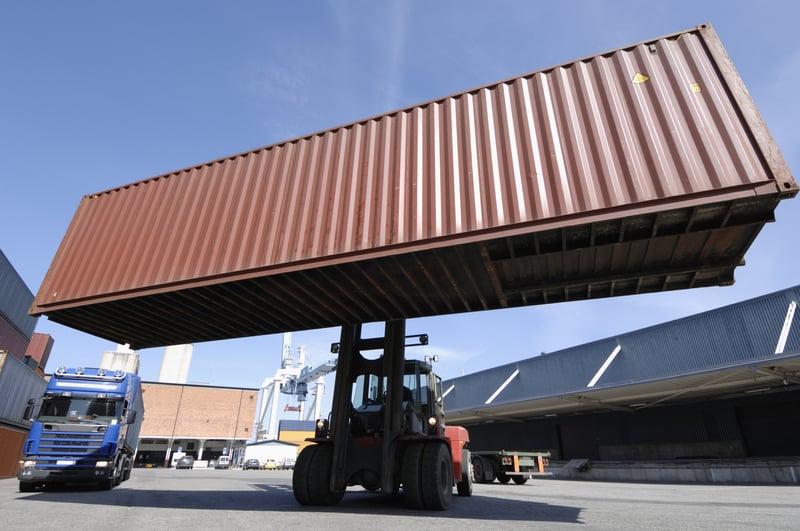Choosing Between the Different Types of Forklift Tires
Whether working in busy warehouses, fast-paced ports, or on bustling construction sites, forklifts are a common sight in many industries. Despite the different ways these industries use forklifts, one factor is shared by all: improving the efficiency and productivity of its machinery can positively impact an operation’s bottom line. A simple step toward getting the best performance from a forklift is to equip it with the right tires for the job.

While there are numerous factors that go into choosing forklift tires, one of the most fundamental considerations is whether to use pneumatic radial, pneumatic bias, press-on band, or resilient solid tires.
Pneumatic Radial and Bias Forklift Tires
Pneumatic forklift tires are similar to the tires found on the cars, trucks, and trailers you see on the road every day. Pneumatic tires are filled with air and are manufactured in two unique ways, the result of which is tires with distinct characteristics:
- Radial tires are built in two parts with plies that run 90 degrees from the direction of travel, wrapped with radial bands that run under the tread. This two-part construction allows the sidewalls and tread of the tire to work independently from one another, which helps reduce rolling resistance, improve heat dissipation, increase puncture resistance, and enhance the tire’s footprint.
- Bias tires are made by laying multiple plies diagonally over one another to create a tire that functions as a single unit with the sidewall and tread areas working together. Bias construction results in tires with strong, stiff sidewalls that resist slashing and cutting and offer excellent stability.
Pneumatic tires provide the most comfortable ride of all the different types of forklift tires; the air in the tire acts as suspension, minimizing both operator fatigue and wear and tear on machines. Pneumatic tires—particularly radials—are also superior at dissipating heat (the #1 enemy of tires), making them the go-to choice for machines that travel long distances, work nonstop, and do a significant amount of starting and stopping.
Pneumatic tires are known for their versatility and it’s common to see forklifts equipped with them working a wide variety of jobs on all sorts of surfaces. Featuring a large, even footprint that conforms to the ground and offering excellent traction, pneumatic tires are ideal for jobs in tough terrain such as those found on construction sites or in dirt yards. Additionally, pneumatic tires typically provide more ground clearance than press-on band tires (see below), allowing them to move more easily on uneven surfaces.
Note: Pneumatic tires require more upkeep than both press-on band and solid tires. For optimal performance, pneumatic tires require proper inflation pressure, which is something forklifts using other types of tires don’t need to worry about.
Solid Press-On Band Forklift Tires
Solid press-on band tires are made by fusing a thick sheath of rubber compound to a metal band. This results in a super-strong, extremely tough tire that can carry heavy loads and delivers exceptional stability. Solid press-on band tires are well-suited to smooth indoor surfaces like those found in warehouses and distribution centers. They also thrive on machines that frequently operate on metal ramps with teeth or holes, which are notorious for damaging pneumatic tires.
The most notable traits of solid press-on band tires are their resistance to scrubbing when running on hard surfaces, puncture-proof construction, and long lifespans. Additionally, solid press-on band tires typically have a lower profile than pneumatics, which boosts machine maneuverability and creates a smaller turn radius. Their lower center of gravity also improves machine stability when carrying an elevated load.
Note: Unlike pneumatic and resilient solid tires, which generally can be used interchangeably, some forklifts are specifically designed for use with solid press-on band tires.
Resilient Solid Tires
Bridging the gap between pneumatic tires and press-on band tires are resilient solid tires. Sometimes called pneumatic solids, due to their similar appearance to traditional pneumatic tires, the difference is that rather than being filled with air, resilient solids are made of solid rubber, commonly using multiple layers of unique rubber to determine performance—engineers can tweak the compounds used in solids to enhance characteristics like longevity and cushioning.
Resilient solids are a common replacement for pneumatic tires, as they offer the puncture-proof performance of a press-on tire with a softer ride more reminiscent of an air-filled tire. Although they’re not quite as versatile as pneumatic tires, resilient solids are able to work in a variety of terrain; it’s common to see solid resilient tires working both indoors and outdoors, in jobs such as scrap yards and demolition sites where the threat of puncture is high.
Galaxy Forklift Tires
Although the decision between pneumatic or solid vs. press-on band tires is made when a forklift is purchased, the tire decisions you make throughout your forklift’s life will largely influence everything from performance to profit. Tires also account for up to a third of fleet maintenance costs; consequently, equipping a forklift with the right tires will cut down replacement costs and machine downtime. The key when choosing a forklift tire is to match your machine’s tires to the terrain they’ll operate in and the tasks they’ll perform.
If you need help selecting an application-specific tire for your forklift, or simply want to learn more about our line of Galaxy forklift tires and how they can benefit your operation, contact your local dealer or rep today.


